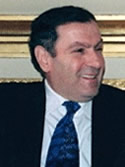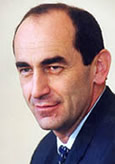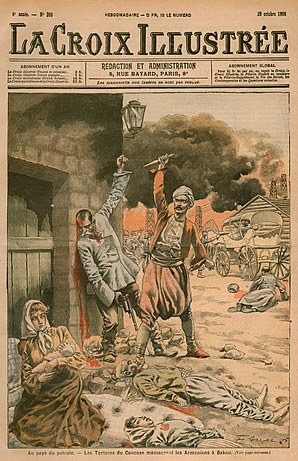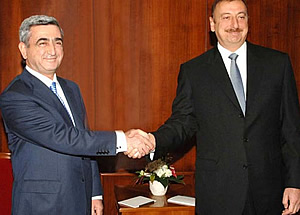Independence
Massacres in Baku
 The Armenian refugees from Baku evacuated to Krasnovodsk, Turkmenistan, in January, 1990
The Armenian refugees from Baku evacuated to Krasnovodsk, Turkmenistan, in January, 1990
In January 1990, the Azerbaijan capital of Baku exploded into chaos and anarchy. The extremists from the Popular Front of Azerbaijan in fact seized the power, making extermination or expulsion of the Armenians their banner. From January 10, mass pogroms took place, resulting in the slaughter of hundreds. Many Armenians were shot, burned alive, raped, and tortured in barbaric fashion. Hundreds of thousands of refugees then flooded Armenia.
The Sovereignty of Armenia proclaimed
Just like some of the republics of the decaying Soviet Union, Armenia proclaimed its sovereignty, adopting the supremacy of the Armenian Constitution over the Constitution of the USSR. Levon Ter-Petrossian, member of Karabakh Committee and leader of ANM, was elected Chairman of the Armenian Supreme Council.
Massacres and deportations in Karabakh
In the spring of 1991, the united Azeri and Soviet militia forces began the so-called “Circle” operation in the Armenian-populated villages of Shahumian, Khanlar and Shusi districts. Under pretext of “passports checking”, the Azeri and Russian militiamen started unparalleled robbery and killing. During the deportation of 24 Armenian villages some 100 Armenians were killed. In despite of several protests of the Armenian Government, the purges continued with growing cruelty and impunity.
In the summer of 1991, the leaders of Artsakh appealed to the United Nations, asking to prevent the physical annihilation of the population. At the same time, the leaders of Artsakh understood that the impotence of the central Soviet power and the new political situation necessitated the new strategy in the task of reunification of Armenia and Artsakh. Now they headed for laying foundation of a proper State in Artsakh. A Declaration proclaiming the foundation of the Nagorno-Karabakh Republic (NKR) was made in early September 1991.
Referendum in Armenia
 Levon Ter-Petrossian
Levon Ter-Petrossian
The Soviet Empire de facto collapsed in the August of 1991, after an attempt to stage a coup failed in Moscow. A referendum was organized in Armenia on September 21, 1991, the Armenian residents voting overwhelmingly for the secession from the USSR. Thus, after 70 years of Soviet ruling Armenia became an independent State. In October 1991, the presidential elections took place in Armenia. Levon Ter-Petrossian became the first popularly elected President in Armenian history.
Referendum in Karabakh
Meanwhile, the situation in Artsakh turned critical, as Azerbaijan began systematic bombing of the Armenian-populated areas. The Azeri-populated villages and the city of Shushi were converted into the military bases. After the disintegration of the USSR the Soviet Army units withdrew from Azerbaijan, and the latter became holder of a large amount of armament and military equipment.
On December 10, 1991, 98% of Artsakh residents voted for the independence of Nagorno-Karabakh Republic in a referendum carried in presence of the international observers and Human Rights Watch groups.
Azerbaijan answered by intensive bombing of Stepanakert, the capital of Artsakh, in which it used the deadly “Grad” rocket projectiles banned by the International Conventions. At the same time, the armed forces of Azerbaijan began the large-scale offensive against the infant Republic (for more information about the war please see History of Artsakh, part 3
Truce
A truce has been in effect since May of 1994, but the conflicting sides did not make any substantial progress in finding a peaceful resolution of the problem. Azerbaijan continues to appeal to the international community trying to play the so-called “oil card”. Armenia confirms itself ready to support any decision approved by Nagorno-Karabakh Republic. The latter, in its turn, is inflexible in its will to obtain the complete independence.
Kocharyan becomes President of Armenia
 Robert Kocharyan In March of 1997, Ter-Petrossian appointed as Prime Minister Robert Kocharyan, President of Nagorno-Karabakh Republic. Kocharyan declared struggle against corruption and tax evasion his priorities. In Artsakh, the presidential elections took place. Arkady Ghukassian, former NKR Minister of Foreign Affairs, was elected President of the NKR. In February 1998, as a disagreement occurred concerning the Karabakh issue between the President and the members of his administration, Ter-Petrossian resigned. In March 1998, Robert Kocharyan was elected President of Armenia.
Robert Kocharyan In March of 1997, Ter-Petrossian appointed as Prime Minister Robert Kocharyan, President of Nagorno-Karabakh Republic. Kocharyan declared struggle against corruption and tax evasion his priorities. In Artsakh, the presidential elections took place. Arkady Ghukassian, former NKR Minister of Foreign Affairs, was elected President of the NKR. In February 1998, as a disagreement occurred concerning the Karabakh issue between the President and the members of his administration, Ter-Petrossian resigned. In March 1998, Robert Kocharyan was elected President of Armenia.
On October 27, 1999 a shocking terrorist attack in the Parliament building in Yerevan took place, in which the Prime Minister Vasken Sarkissian and the Parliament Speaker Karen Demirchyan were killed. However, Robert Kocharyan stood firm during the crisis.
Kocharyan was reelected in 2003, beating Stepan Demirchyan in the second round of elections. Kocharyan continued to negotiate a peaceful resolution with Azerbaijani President Ilham Aliyev on the status of Nagorno-Karabakh. Talks held in Astana, Kazakhstan, and then in Rambouillet, France. No agreement was produced. Further meetings, in Minsk and Moscow in November 2006 brought no results.
Serge Sargsian
 Serge Sargsian
Serge Sargsian
The new presidential elections held on February, 2008. Serge Sargsian, former Prime Minister, won with 53% of vote. However, former President Levon Ter-Petrossian who was in second place with 21.5% of the vote, accused the government of rigging the election and claimed victory. Continuous protests started in Yerevan adn lasted for 10 days. The situation aggravated on March 1st, when reportedly acting on evidence of firearms in the camp, police moved in to inspect the tents set up by demonstrators, and finally dispersed the protesters with violence. 10 people died in confrontation, and a state of emergency was implemented by President Kocharyan. Sargsyan was recognized as legitimate president.










